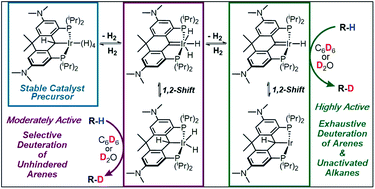H/D exchange under mild conditions in arenes and unactivated alkanes with C6D6 and D2O using rigid, electron-rich iridium PCP pincer complexes†
Abstract
The synthesis and characterization of an iridium polyhydride complex (Ir-H4) supported by an electron-rich PCP framework is described. This complex readily loses molecular hydrogen allowing for rapid room temperature hydrogen isotope exchange (HIE) at the hydridic positions and the α-C–H site of the ligand with deuterated solvents such as benzene-d6, toluene-d8 and THF-d8. The removal of 1–2 equivalents of molecular H2 forms unsaturated iridium carbene trihydride (Ir-H3) or monohydride (Ir-H) compounds that are able to create further unsaturation by reversibly transferring a hydride to the ligand carbene carbon. These species are highly active hydrogen isotope exchange (HIE) catalysts using C6D6 or D2O as deuterium sources for the deuteration of a variety of substrates. By modifying conditions to influence the Ir-Hn speciation, deuteration levels can range from near exhaustive to selective only for sterically accessible sites. Preparative level deuterations of select substrates were performed allowing for procurement of >95% deuterated compounds in excellent isolated yields; the catalyst can be regenerated by treatment of residues with H2 and is still active for further reactions.

- This article is part of the themed collection: Celebrating 10 years of Chemical Science


 Please wait while we load your content...
Please wait while we load your content...